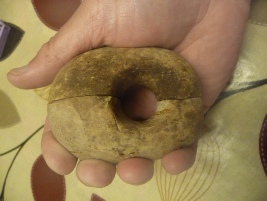

In the autumn of of 2015-
Following a de-
The presence of a circle of large and partly shaped fallen stone orthostat slabs suggested that it was perhaps once a dominant landscape feature; either a stone circle or kerb cairn burial monument.
The size and distance between the stones did resemble a kerb cairn, a type of monument common to parts of upland Ceredigian. Moreover, this was large at about 12 metres in diameter and was ellipsoid in shape.
In 2016 a full excavation of the SW and NE quadrants revealed only a shallow depth to bedrock (shales of the Rhuddnant grits) an outcrop which had clearly been quarried in the northern half of the monument to detach large blocks which made up 70% of the large and small orthostats.
Some 10-
This suggested an ellipsoid circle of stones, with perhaps smaller ones without sockets
in between, of 9m diameter (N-
Charcoal including hazelnut shell, was found in small amounts in a soil beneath the
shallow shaly cairn material in the middle, associated with several small pits and
some poorly defined burnt spreads. An off-
More importantly was the find of two halves of a broken Late Neolithic-
Further radiocarbon dating of some of the charcoal fragments from this feature will be attempted in due course.







This website was made possible by a grant from the Cambrian Archaeology Association